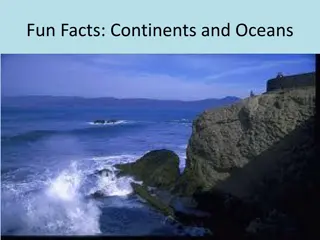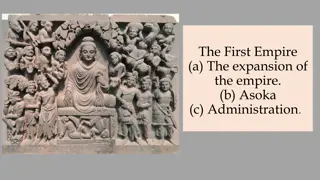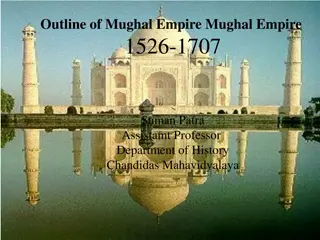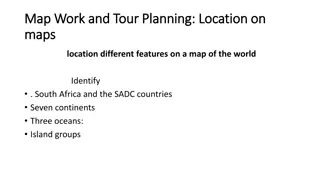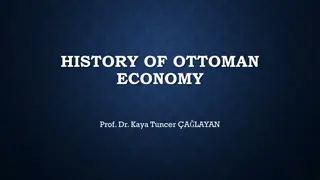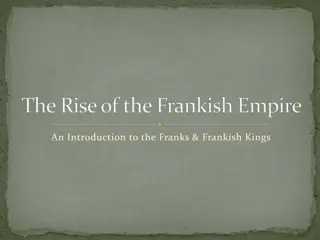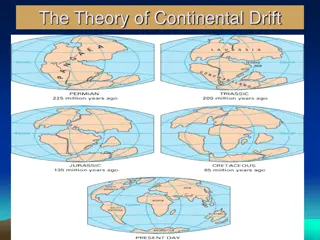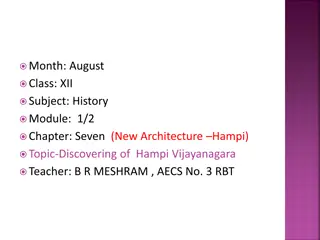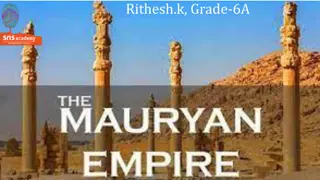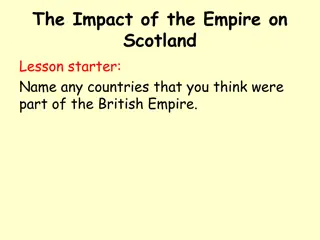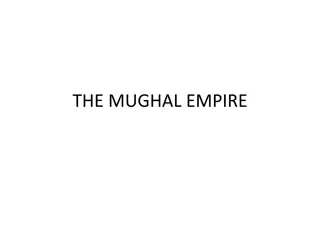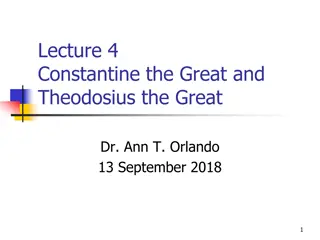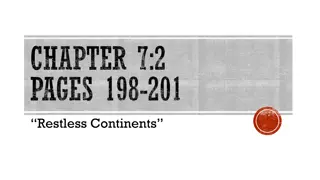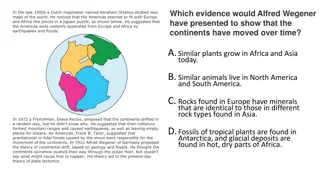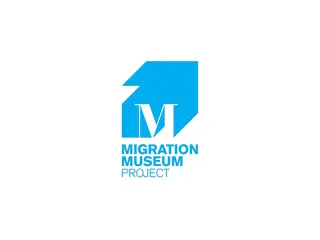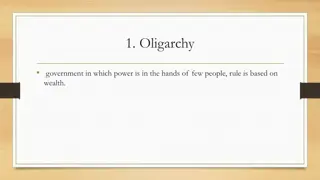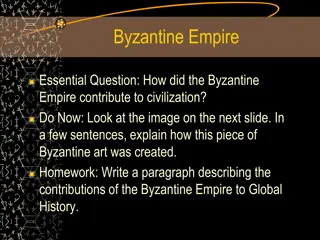An Empire Across Three Continents - A Historical Journey
Explore the fascinating history of an empire spanning three continents, from the rise of trade networks in the Assyrian empire to Alexander the Great's conquests and the evolution of Rome into a dominant power. Discover the shared cultures, languages, and sources that illuminate the rich past of these ancient civilizations.
Download Presentation

Please find below an Image/Link to download the presentation.
The content on the website is provided AS IS for your information and personal use only. It may not be sold, licensed, or shared on other websites without obtaining consent from the author.If you encounter any issues during the download, it is possible that the publisher has removed the file from their server.
You are allowed to download the files provided on this website for personal or commercial use, subject to the condition that they are used lawfully. All files are the property of their respective owners.
The content on the website is provided AS IS for your information and personal use only. It may not be sold, licensed, or shared on other websites without obtaining consent from the author.
E N D
Presentation Transcript
CLASS XI SUBJECT: HISTORY TOPIC: AN EMPIRE ACROSS THREE CONTINENTS Made By: Anupam Handa PGT-History Air Force School, Ambala Cantt handa.anupam@gmail.com
INTRODUCTION By established control over major parts of the Assyrian empire. Networks of trade developed overland, as well as along the coasts of the Mediterranean Sea. Mediterranean, Greek cities and their colonies benefited from improvements in trade that were the result of these changes. They also benefited from close trade with nomadic people to the north of the Black Sea. the sixth century BCE, Iranians had In the eastern
From among the Greek states, in the late fourth century BCE, the ruler of the kingdom of Macedon, Alexander, undertook a series of military campaigns and conquered parts of North Africa, West Asia and Iran, reaching up to the Beas. Here, his soldiers refused to proceed further east. retreated, though many Greeks stayed behind. Throughout the area control, ideals and cultural traditions were shared amongst the Greeks and the local population. The region on the whole became Hellenised (the Greeks were called Hellenes), and Greek became a well-known language throughout. Alexander s troops under Alexander s
FEATURES At the time, Rome was a republic. Government based on a complex system of election, but its political institutions importance wealth and society benefited from slavery. In the middle of the first century BCE, under Julius Caesar, a high-born military commander, Empire was present-day Germany was gave to some and birth this extended Britain Roman to and
SOURCES TO KNOW ABOUT ROMAN HISTORY a) Texts c)Material Remains b) Documents
Textual include histories of the period written by contemporaries (these were usually called because narrative constructed year-by-year letters, sermons, laws, and so on sources Annals , the was on basis), a speeches,
Documentary sources include mainly inscriptions and papyri. Inscriptions were usually cut on stone, so a large number survive, in both Greek and Latin. Papyrus scrolls are also important in this field.
WHAT IS PAPYRUS? The papyrus was a reed-like plant that grew along the banks of the Nile in Egypt and was processed to produce a writing material that was very widely used in everyday life. Thousands of contracts, accounts, letters and official documents survive on papyrus and have been published by scholars who are called Papyrologists .
Each sources can only tell us just about the past, and combining them can be a fruitful exercise, but how well this is done depends on the historian s skill! of these so much
Material include a very wide assortment that archaeologists discover (for example, through and field survey), for example, monuments and other kinds of pottery, mosaics, even entire landscapes example, through the use of photography). remains of items mainly excavation buildings, structures, coins, (for aerial
IRANIAN EMPIRE ROMAN EMPIRE The Roman Empire stretched from Spain in Europe to Syria in the East Mediterranean Sea in to Africa's desert. In the north its boundaries were marked by the river Rhine and Danube. In the South by the Sahara desert. Iran the south of Caspian Sea to Arabia times large parts of Afghanistan. controlled entire area along the eastern and a MOST POWERFUL EMPIRES
THE PHASES OF ROMAN EMPIRE The Roman Empire can broadly divide into two phases-Early Empire and Roman Empire. The period down to the main part of the 3rd century can be called the 'early empire'. The period after Century can be called the 'late empire'. Roman Late whole 3rd
DIFFERENCE BETWEEN THE ROMAN EMPIRE AND IRANIAN EMPIRE Roman Empire had a diverse population as compared to that of Iran. The Parthians and Sasanians dynasties, that ruled Iran in this period, ruled largely over the Iranian population. Whereas the Roman Empire was a variety of territories and cultures bound by the common system of govt. Many languages were spoken in the Roman Empire, but for the administrative purposes only Greek and Latin were used. The upper class of east spoke Greek and those in the western part spoke Latin. All the people in the Roman Empire were subjects of single ruler, the emperor, irrespective of where they lived and what language they spoke.
THREE MAIN PLAYERS IN THE POLITICAL HISTORY OF THE EMPIRE The Emperor (Source of Authority) The Senate (Body of Wealthy Families) The Army (Paid & Professional)
FEATURES OF ROMAN ARMY & SUCCESSION TO THE THRONE IN THE ROMAN EMPIRE The Army which was a paid and professional army where soldiers had to put up twenty five years of service. The existence of paid army was a distinctive feature of the Roman Empire. The army was the largest single organized body of the Roman Empire. It had the power to decide the fate of the emperors. The army was hated by the Senators. Thus, it can be said that the emperor, the aristocracy, and the army were the three players in the political history of the empire. Family descent, either natural or adoptive, was the decisive factor in the succession to the throne in the Roman Empire. The army was also wedded to this concept. For e.g. Tiberius was not the natural but adopted son of Augustus.
THE AUGUSTAN AGE The Augustan age is remembered as the age of brought peace after decades of internal strife and centuries of military conquest. warfare much less common in the centuries. peace. It External was also first two
ADMINISTRATION OF THE VAST ROMAN EMPIRE The vast Roman Empire was controlled and administered wit h the help of urbanisation.All the territories of the empire were organized in to provinces and were subject to taxation. Carthage, Alexandria, Antioch that lined the shores of Mediterranean were the foundations of the imperial system. It was through these cities that the government was able to collect tax from the provincial countryside which generated much of the wealth. This shows that the local upper class was actively involved with the Roman state in administering their own territories and collecting taxes from them.
Throughout the second and third century the provincial upper classes provided experienced officers that administered the provinces and commanded the army. Thus, they became the new elite of the Roman Empire. They controlled the army and looked after the provincial administration. They became much more powerful than the senatorial class because they had the backing of the Emperors. Emperor Gallienus consolidated their rise to power by excluding senators from military command. He did this in order to prevent control of the empire from falling in to their hands.
MEANING OF ROMAN CITY An Urban centre with its own magistrates, city council territory villages jurisdiction. The villages could be upgraded to the status of city and vice-versa generally as a mark of favour from emperor and a containing under its the
THE THIRD CENTURY CRISIS The first and second centuries were a period of peace, prosperity and economic expansion. But the third century was a period of crisis. In 225, new dynasty called Sasanians emerged in Iran. They were more aggressive and expanding rapidly in the direction of the Euphrates. The Germanic tribes (barbarians) began to move against the Rhine and Danube frontiers. From 233 to 280 saw repeated invasions. The Romans were forced to abandon much of the territory beyond the Danube. The quick succession of emperors (25 emperors in 47 years) is a sign of strain faced by the empire in the 3 rd century.
OTHER ASPECTS Status of women The women enjoyed considerable legal rights in owning and managing property. They were married off in the late teens or early thirties. Arrange marriage was the general norm. Women remained a primary heir to father's marriage. They could become independent property owners after their Divorce was easy for both men as well as women. property after father's death.
women were often subject to domination by their Wives were beaten up by their husbands. The typical form of marriage was one where the wife did not transfer to her husband's but retained rights in the property of her natal family. husbands even authority full
Rate of literacy: It varied great between different parts of the empire. Literacy was widespread in army officers, managers soldiers literacy existed and it varied from place to place here was a wall in Pompeii carried advertisements graffiti, indicates high level of casual literacy. estate and Casual . which and which
CONTROLLING OF WORKERS Slavery was an institution deeply rooted in Ancient Roman world. Though slavery was institutionalized and was greatly used as labour but it was not always slaves that performed labour in the Roman economy. As peace was established in the first century, the supply of slaves declined and users of slave labour had to turn to slave breeding or cheaper substitutes such as wage labour which were easily dispensable.
LATE ANTIQUITY Late antiquity is the term used to describe the final, fascinating period in the evolution and break-up of the Roman Empire and refers from the fourth to seventh centuries. The period saw considerable changes in cultural, economic, and administrative levels.
WORKS IN LATE ANTIQUITY PERIOD The emperor Diocletian abandoned territories with little strategic and economic importance. He fortified frontiers, recognized provincial boundaries and separated civilian from the military functions.
The most important innovations of Constantine were in the monetary sphere. He introduced Solidus, a coin weighing 4 gm of pure gold. These coins were minted in millions. The other innovation was the creation of a second capital at Constantinople. The late Antiquity period witnessed considerable change in economic life. Emperor Constantine Christianity as official religion of the Roman empire.(4th century) declared
DECLINE OF THE ROMAN EMPIRE Large parts of the Roman and Iranian Empires had fallen into the hands of the Arabs. Nomadic tribes in frontier areas such as Goths, Visigoths, Vandals and others attacked the Roman Empire in the west by the 5th century C.E. The Germanic groups established their own kingdoms within the empire. With the prompting of the Christian Church, a Holy Roman Empire was formed from some of these kingdoms from the 9th century CE. The Roman Empire was divided in to eastern and western halves in the fourth century C.E.
SOURCES www.ncert.nic.in www.mycbseguide.com https://studytution.com www. cbseocean.weebly.com http://edurev.in http://extramarks.com http://learncbse.in
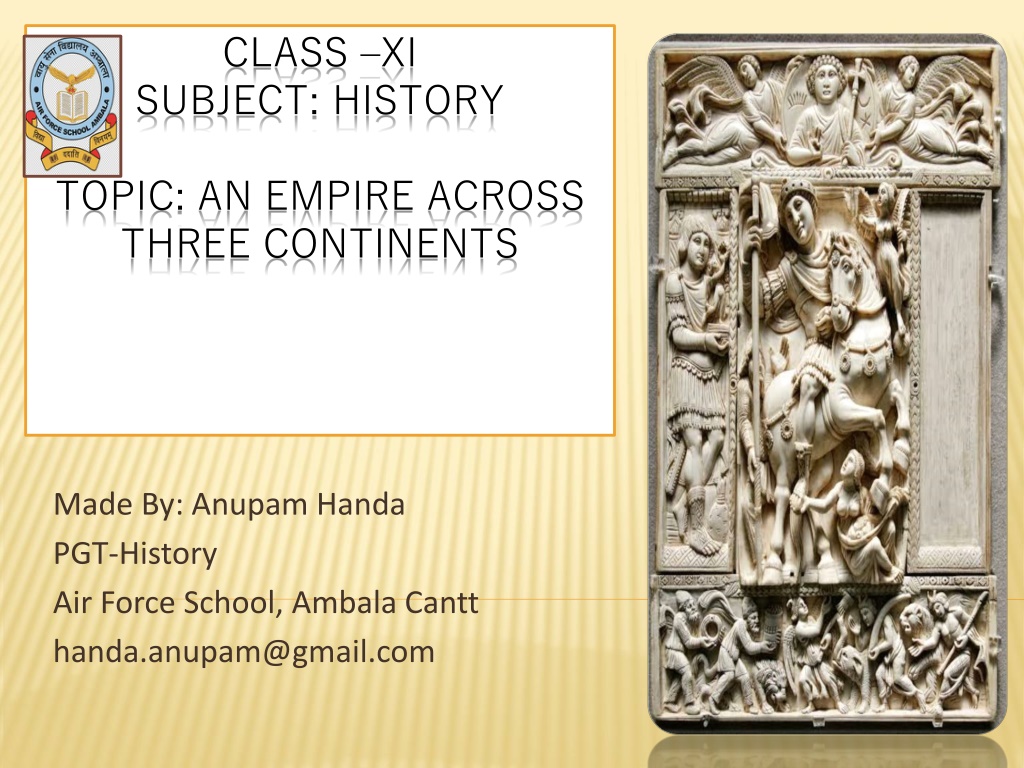
 undefined
undefined










